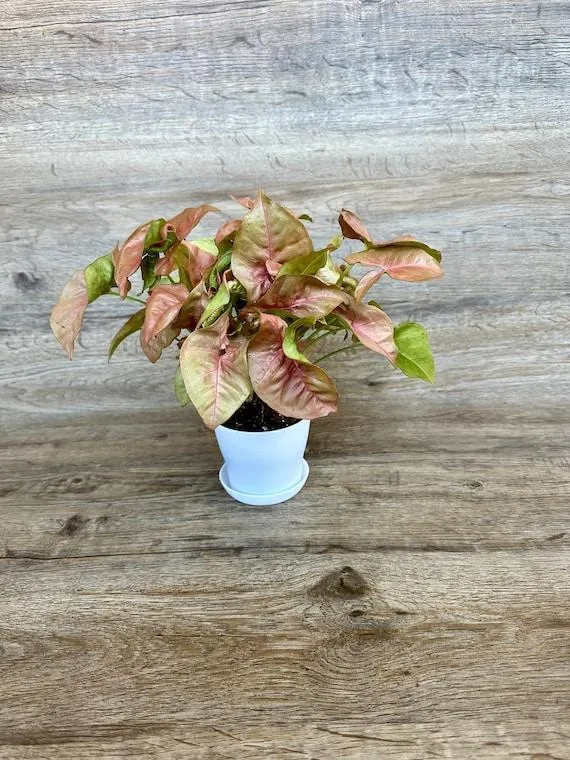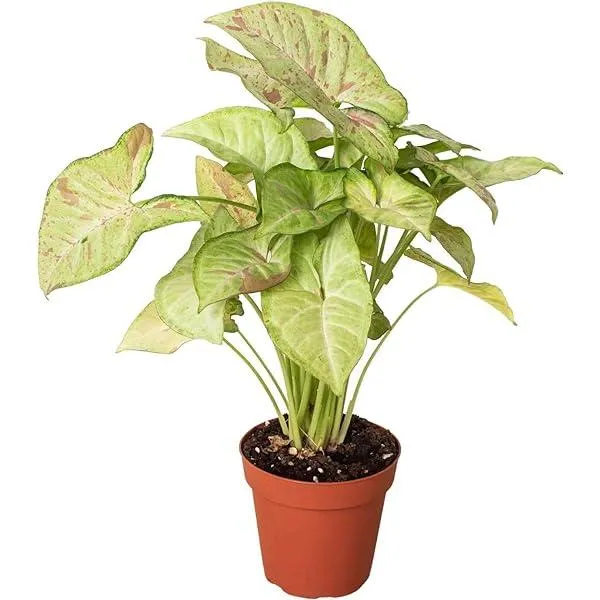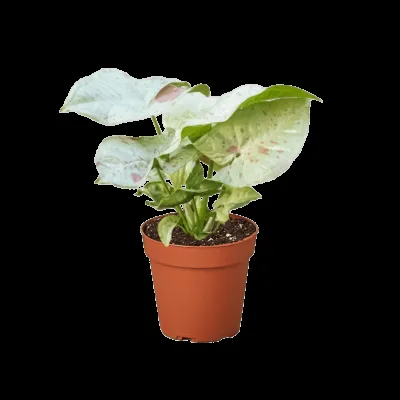Is a Syngonium Plant Safe for Cats?
While syngonium plants are non-toxic and generally safe for cats, there are a few things cat owners should know before bringing one into their home. In this article, I’ll discuss the potential risks of syngonium exposure for cats and provide tips on cat-proofing your plants.
Syngonium Toxicity Level
- Syngonium plants, also known as Arrowhead vines or Nepthytis, are considered non-toxic to cats according to the ASPCA Animal Poison Control Center.
- They are rated as an “Irritant” on the toxicity scale, meaning ingestion may cause mild gastrointestinal upset.
- However, due to the presence of small crystals called raphides in their leaves and stems, syngonium can potentially cause mild to moderate mouth irritation if nibbled or eaten by cats.
From my experience as a cat owner and plant lover, even non-toxic plants deserve some caution around curious cats. While syngonium may not land your cat in the animal ER, it’s best to take precautions to avoid any discomfort.
Potential Irritation Risks of Syngonium for Cats
The main risks associated with syngonium exposure stem from the mouth irritation potential of those tiny raphide crystals I mentioned earlier. If your cat gets enthusiastic with a syngonium leaf and does some serious chomping, a few minor side effects may occur:
- Drooling or excessive salivation
- Face rubbing or pawing at the mouth
- Temporary refusal to eat
- Gastrointestinal upset like vomiting (less common)
Symptoms would typically be mild and short-lived if the leaf was spit out promptly. However, it’s best to avoid these situations altogether if possible. Kinda like when you accidentally bite into a hot pepper – not a fun experience!
Cat-Proofing Your Syngonium
No plant is 100% cat-proof, but there are some precautions you can take as a syngonium owner to minimize the chances of any mishaps. Here are my top tips:

- Place the plant out of reach on high shelves, hanging baskets or cat-free rooms.
- Use furniture to block access like bookcases under hanging plants.
- Give cats other engaging plants that are totally non-toxic as acceptable flossing substitutes.
- Cover soil in the pot with decorative gravel to discourage digging and ingestion.
- Consider a protective barrier like a thin fencing or plastic guard around base of plant.
- Monitor kitty interactions with all plants and redirect any biting or chewing behaviors.
Basically, the key is “out of sight, out of mouth” – if the syngonium temptation can be removed, problem solved! But is it worth all that effort for a supposedly “safe” plant? Might be kinda a hassle, if you ask me.
Alternative Plant Picks for Cat Parents
While syngonium can work with proper precautions, there are lots of other great low-light houseplants that pose zero risk to your feline friends. Here are some top cat-safe plant pics from my own collection:
- Sansevieria (snake plant) – Virtually indestructible and loves neglect. Great for busy cat guardians.
- Pothos – Super easy to care for trailing vines. Provides optimum pet flossing satisfaction.
- Peperomia – Cute succulent-like leaves in diverse varieties. Helpful foliage to munch mouth irritation away.
- ZZ Plant – Stylish upright plant known to actually improve indoor air quality. A real lung saver amiright?
- English Ivy – Catnip’s leafier cousin that’s just as fun to chew on without side effects. Win win!
Basically all those popular low-effort houseplants are cool cat companions. So why risk irritation bites with your syngonium when there’s safer plant pals out there? Makes you think, don’t it…
Final Thoughts on Syngonium and Cats
In summary, while syngonium itself is generally non-toxic to cats, there are valid concerns over potential mouth irritation from the plant’s raphide crystals if ingested. Proper cat-proofing takes dedication to keep curious kitties away.
Other super low-maintenance and totally cat-safe houseplants provide optimal foliage enjoyment without the headache. Maybe syngonium just isn’t worth the hassle when such easy alternatives thrive beside our feline friends, ya know?

So in the end, while syngonium may be an option for cat owners who rigorously monitor plant interactions, it’s probably best to choose cat-friendly foliage without any risks – however slim. The peace of mind is so worth it, if you ask me! But hey, you do you.
So in summary-summary, be mindful of syngonium around cats due to possible mouth irritation. But there’s no need to fret over perfectly pet-proof picks either. The choice is yours, fellow cat guardian! Now go floss with your favorite feline lol.
Key Facts for Choosing a Syngonium Plant
| Type | Description | Care Level |
|---|---|---|
| Syngonium podophyllum | Arrowhead vine. Heart shaped leaves with white veins. Trails or climbs. | Easy |
| Syngonium albo-variegatum | White butterfly. Large arrowhead leaves with white variegation. | Easy |
| Syngonium erythrophyllum | Arrowhead vine. Red leaves that fade green with age. Vigorous climber. | Easy |
| Syngonium podophyllum ‘Maria Allusion’ | Dark arrowhead leaves with cream variegation. Bushy habit. | Easy |
| Syngonium podophyllum ‘White Butterfly’ | Large arrowhead leaves with dramatic white variegation. Trails or climbs. | Easy |
FAQ
-
What is a syngonium plant?
A syngonium plant is a kind of vine or climber commonly known as an “arrowhead plant”. It’s a houseplant that folks grow basically as decoration. Syngonium vines have arrow-shaped leaves and come in all sorts of colors like green, white, pink, and variegated.
-
Do syngonium plants need lots of sunlight?
While syngoniums can tolerate lower light conditions, they sort of thrive with bright, indirect sunlight. Too much direct sun might scorch their leaves, but they definitely don’t want to be in complete shade. So a spot near an east or west window seems to suit them best. The plant appears to reach out towards the light with its climbing vines.
-
How often should I water my syngonium plant?
These plants need moisture but not too much. The soil should dry out somewhat between waterings, maybe once a week or so. Overwatering is basically one of the biggest causes of death for houseplants. Remember – it’s always better to underwater than to drown the poor thing! You can use your finger to check the soil depth for moisture content as a guide.

-
Do syngoniums need fertilizer?
Fertilizing during the growing season, maybe in spring and summer, seems to give syngoniums a boost. You can use a houseplant fertilizer diluted to half strength every few months. But take it easy – too much nitrogen can cause soft growth that’s prone to pests. So basically go light on the feed to avoid tipping the plant balance.
-
Can syngonium vines get really long?
Given the right conditions like a moss pole or trellis to climb, syngonium vines can literally grow amazingly long – like several feet! They seem to just keep reaching higher towards the sunlight. Of course, factors like pot size and pruning might hold them back a bit. But for the most part, these vines appear to have no natural stopping point.
-
Are syngoniums poisonous to pets?
Most plant guides do list syngonium as being toxic to cats and dogs if they decide to chew on the leaves. However, the degree of danger seems to vary widely between reports. While it’s always better safe than sorry with pets, there don’t seem to be too many verified accounts of syngonium actually causing any adverse effects. But hey, is it worth the risk to find out? I’d say better safe than dealing with an upset tummy!
-
What problems might syngoniums face?
The most common issues for syngoniums appear to be yellow leaves from overwatering or low light, along with pests like spider mites or mealybugs resulting from poor conditions. Rotting around the stem or soil line can happen in wet soil too. But generally these are sturdy plants that don’t seem to face too many magnificent problems. A little TLC seems to keep syngoniums happy!
-
Should I trim my syngonium back?
Pruning syngonium vines from time to time can help stimulate new growth and keep them bushy. Cutting back leggy parts can also aid air circulation to reduce diseases. However, there’s really no need to get too aggressive with trimming unless you want to control their size for a pot. Maybe try thinning versus lopping – you wouldn’t want to damage their amazing ability to climb! Occasional light shaping seems to do the trick.

